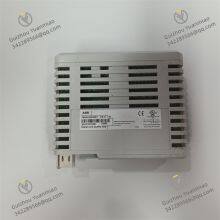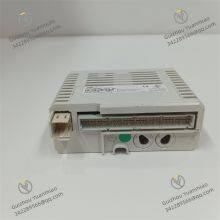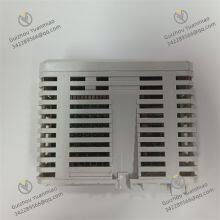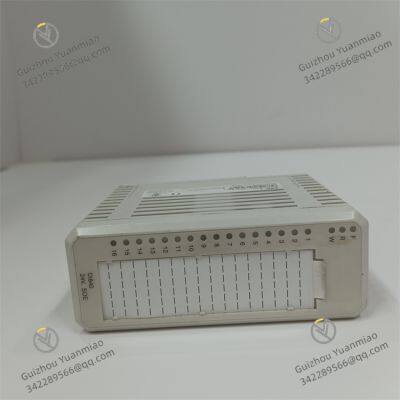I. Product Overview
ABB DI840 3BSE020836R1 is a high-performance digital input module. It adopts a compact structure, with its overall dimensions carefully optimized to fit well into standard industrial control cabinets. Its small size not only saves installation space but also facilitates flexible installation in complex cabinet layouts, easily integrating into both the centralized cabinets of large industrial control systems and the compact spaces of small automation equipment. The module is lightweight, greatly facilitating the operation of installers, reducing labor intensity during installation, and at the same time, reducing additional costs during transportation.
The shell is made of high-strength, corrosion-resistant industrial-grade materials, with excellent protective performance. It can effectively resist the impact of adverse factors common in industrial sites such as dust, oil stains, and slight collisions, providing a solid protective barrier for internal precision electronic components, ensuring that the module can still operate stably for a long time in harsh industrial environments, and extending the service life of the module.
The core function of the DI840 module is to realize the collection and transmission of digital signals. It can be connected to various devices that generate switching signals, such as limit switches, buttons, relay contacts, proximity switches, etc. It accurately collects the on-off status output by these devices (such as the start-stop of equipment, the opening-closing of valves, fault alarms, etc.) in the form of digital signals and transmits them to the upper-level control system in real-time, providing first-hand on-site status information for the decision-making of the control system. It is an important part of the data collection link in the industrial automation control system.

II. Performance Parameters
(1) Electrical Characteristics
Power supply voltage: It uses 24VDC DC power supply. This voltage specification is a universal standard in the industrial field and can be perfectly compatible with most industrial DC power supply systems. No additional power conversion devices are needed, which simplifies the power supply design of the system, reduces the risk of failures caused by power mismatch, and also facilitates users to quickly access the existing power supply network.
Power consumption: In normal working condition, the power consumption of the module is extremely low, only about [specific power consumption value, such as 2.5W]. The low-power design is not only conducive to reducing the energy consumption of the entire automation system, in line with the development trend of energy conservation and environmental protection, but also can reduce the heat generation of the module itself, avoid affecting the performance and service life of internal electronic components due to overheating, and improve the stability of the module during long-term continuous operation.
(2) Input Characteristics
Input type: It supports two digital input types: dry contacts and wet contacts. Dry contact input does not require an external power supply and is suitable for connecting various mechanical contact switches, such as buttons, limit switches, etc. The on-off of its signal is only determined by the closing and opening of the contacts; wet contact input requires an external specific voltage signal and can be connected to devices that actively output digital signals such as photoelectric sensors and proximity switches, with wide device compatibility, which can meet the signal collection needs in different industrial scenarios.
Number of input channels: The module is equipped with 16 independent digital input channels, which can connect 16 different digital signal sources at the same time to realize synchronous collection of the status of multiple devices or multiple monitoring points. This design significantly improves the efficiency of signal collection. In industrial scenarios where a large number of switching signals need to be monitored, such as the status monitoring of multiple stations in an automated production line and the status feedback of multiple components of large equipment, it can effectively reduce the number of required modules, lower system costs and wiring complexity.
Input voltage range: For wet contact input, the supported voltage range is usually 18-30VDC, which is compatible with the common 24VDC standard voltage signal in industrial sites, ensuring stable connection with various sensors and devices that output 24VDC digital signals, and guaranteeing the accuracy of signal collection.
Response time: The response time of the input signal is extremely short, generally in the range of [specific response time, such as 1ms-10ms] (can be adjusted according to actual parameters). The fast response capability enables the module to timely capture the status changes of the input signal, such as sudden fault signals of equipment, emergency stop signals, etc., ensuring that the control system can respond quickly, and improving the safety and controllability of the industrial production process.

(3) Communication and Integration
Communication interface: The module exchanges data with the upper-level control system through ABB's dedicated communication bus (such as Profibus-DP, EtherCAT, etc., according to the actual module configuration). These dedicated communication buses have the characteristics of high speed, stability, and strong anti-interference ability, which can ensure that the collected digital signals are transmitted to the control system quickly and accurately, meeting the real-time requirements of industrial automation.
System compatibility: It has perfect compatibility with ABB's AC800M and other series of control systems, and can be directly connected to the system bus without additional interface conversion equipment, simplifying the system integration process. At the same time, through appropriate configuration and protocol conversion, it can also interface with control systems of other brands, with certain openness and flexibility, broadening its application range.
(4) Reliability and Protection
Channel isolation: Electrical isolation technology is adopted between each input channel and between the channel and the internal circuit of the module, with an isolation voltage of more than [specific isolation voltage, such as 2500V AC]. This isolation design can effectively prevent signal interference between different channels, avoid the impact on the normal operation of other channels due to a fault in one channel (such as short circuit, overvoltage), and at the same time, protect the internal circuit of the module and the upper-level control system from external electrical faults, improving the reliability of the entire system.
Overvoltage and overcurrent protection: Each input channel is equipped with an overvoltage and overcurrent protection circuit. When the input signal has a voltage or current exceeding the normal range, the protection circuit will act quickly to limit the abnormal current or voltage, preventing damage to the internal components of the module. For example, when an external device is mistakenly connected to an excessively high voltage, the protection circuit can timely cut off the abnormal input of the channel, ensuring the safety of other parts of the module and the entire system.
Self-diagnostic function: It has a perfect self-diagnostic function, which can monitor the power supply status, communication status, and working status of each channel of the module in real-time. When a fault of the module itself (such as power failure, communication interruption) or a channel fault (such as channel short circuit, disconnection) is detected, it will automatically generate a fault code and upload the fault information to the control system through the communication bus. At the same time, the corresponding fault indicator light on the module will light up, providing an intuitive guide for maintenance personnel to quickly locate the fault point, shortening the time for fault troubleshooting and repair, and improving the availability of the system.
Environmental adaptability
Operating temperature range: It can work stably in a wide temperature range of -25°C to +70°C. Whether in cold outdoor industrial places (such as mine equipment control in northern winter) or high-temperature production workshops (such as metallurgical and chemical workshops), the module can maintain normal working performance, ensuring the continuity and accuracy of digital signal collection.
Humidity adaptability: It can operate reliably in an environment with a relative humidity of 5%-95% (non-condensing). In humid industrial environments (such as paper mills, food processing plants), it will not cause circuit performance degradation or short-circuit faults due to humidity issues, ensuring the stable operation of the module under different humidity conditions.
Vibration and impact resistance: It has undergone strict vibration and impact tests and has good vibration and impact resistance. It can withstand vibration with a vibration frequency of [specific frequency range, such as 10Hz-500Hz] and an acceleration of [specific acceleration value, such as 10g], as well as impact with an impact acceleration of [specific impact acceleration value, such as 30g], ensuring that the module can still work stably without being affected by vibration and impact during transportation, installation, and when operating near equipment with large vibrations (such as stamping machines, crushers).

III. Application Scenarios
(1) Automated Production Lines in Manufacturing Industry
In the automated production lines of manufacturing industries such as automobile manufacturing, electronic equipment, and mechanical processing, the DI840 module is widely used. It can be connected to various limit switches on the production line to monitor whether the workpiece is in place; connected to button switches to receive operators' commands such as start, stop, and emergency stop; connected to the fault alarm contacts of equipment to obtain the operating status of the equipment in real-time. For example, in an automobile welding production line, the module collects the working status signals of each welding robot (such as whether welding is completed, whether there is jamming), the operating status signals of the conveyor belt (such as whether it is conveying normally, whether it is deviated), etc., and transmits these signals to the production line control system. The control system coordinates the working rhythm of each device according to these signals. When an abnormality occurs in a certain link, it can timely issue commands to pause relevant processes, avoid the production of unqualified products, and improve production efficiency and product quality.
(2) Petroleum and Chemical Industry
In the petroleum and chemical production process, there are a large number of pumps, valves, compressors and other equipment. The start-stop status of these equipment, the opening-closing status of valves, safety interlock signals, etc., need to be monitored in real-time. The DI840 module can be connected to the status feedback contacts of these equipment to collect their digital signals and transmit them to the DCS (Distributed Control System). For example, in the crude oil pipeline transportation system, the module collects the opening-closing status signals of valves in each section of the pipeline, the running/stopping signals of pumps, the action signals of pressure switches (such as overpressure alarm), etc. The DCS system monitors the entire transportation process in real-time according to these signals. When it detects that the valve is not opened as instructed, the pump stops abnormally, or the pressure exceeds the standard, it can immediately start the corresponding safety interlock program, such as closing relevant upstream and downstream equipment, issuing sound and light alarms, etc., to prevent the expansion of accidents and ensure production safety.

(3) Power Industry
In places such as substations and power plants in the power system, the DI840 module is used to collect status signals of various switchgear. For example, in substations, it collects the opening and closing status of circuit breakers, the position signals of disconnectors, the status signals of earthing switches, etc.; in power plants, it collects the start-stop status of auxiliary equipment of steam turbines and generators (such as lubricating oil pumps, cooling water pumps), the action signals of safety protection devices (such as overspeed protection, over-temperature protection), etc. These signals are transmitted to the power monitoring system. Through the monitoring system, operation and maintenance personnel can grasp the operating status of the equipment in real-time. When the equipment is in an abnormal state, they can handle it in a timely manner to ensure the stable operation of the power system. At the same time, the signals collected by the module are also an important basis for the automatic control and interlock protection of the power system, providing data support for the realization of unattended and intelligent management of the power system.
(4) Metallurgical Industry
In the smelting process of iron and steel and non-ferrous metals in the metallurgical industry, the environment is often harsh, and factors such as high temperature, dust, and vibration have high requirements on the reliability of equipment. The DI840 module can work stably in such an environment and is used to collect status signals of various equipment. For example, in the blast furnace system of a steel plant, it collects the silo level switch signals of the blast furnace feeding system (such as full, empty), the valve opening-closing status signals of the hot blast stove, the operation status signals of the water pump in the cooling system, etc. These signals are transmitted to the blast furnace control system. The control system controls the feeding rhythm, adjusts the working status of the hot blast stove, and ensures the normal operation of the cooling system according to these signals. When an abnormality occurs in a key signal, such as the cooling water pump stops running, the control system can quickly take measures, such as reducing the blast furnace load, starting the backup pump, etc., to prevent high-temperature equipment from being damaged due to insufficient cooling, and ensure the continuous and stable progress of the smelting process.
















































